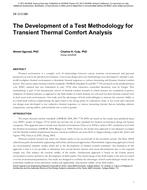Thermal environment is a complex web of relationships between various transient environmental and personal parameters as well as the physical environment. A test room design and a test methodology were developed to simulate a real-world workplace thermal environment to determine thermal responses to various interacting and dynamic thermal comfort factors. The current major thermal comfort standards (ASHRAE Standard 55 and ISO 7730) are based on the predicted mean vote (PMV) method that was formalized in early 1970s after exhaustive controlled laboratory tests by Fanger. This methodology is part of the deterministic school of thermal comfort research in which humans are considered as passive recipients of thermal stimulus as opposed to the field studies in which humans are surveyed for their thermal comfort level in their usual work environments. Our study used the advantages of both methodologies to increase the external validity as in a field study without compromising the rigor which is the strong point of a laboratory study. A test room and a factorial test design were developed to test subjective thermal responses to various interacting thermal factors including ambient temperature, varying airflow, and metabolic rate as well as gender.
Citation: ASHRAE Conference Papers, Denver, CO
Product Details
- Published:
- 2013
- Number of Pages:
- 9
- File Size:
- 1 file , 1.1 MB
- Product Code(s):
- D-DE-13-C080
